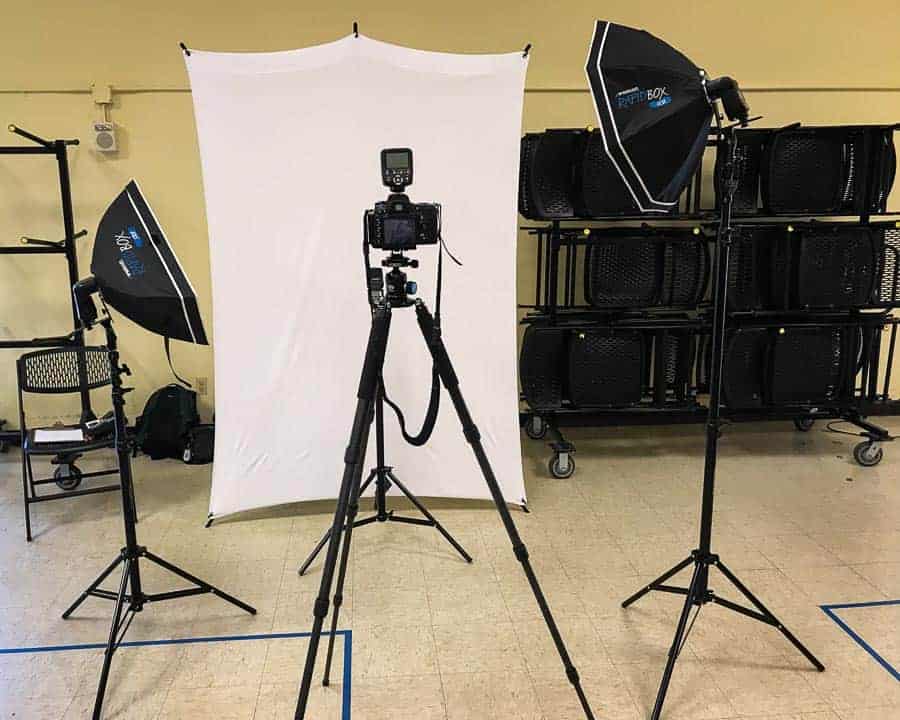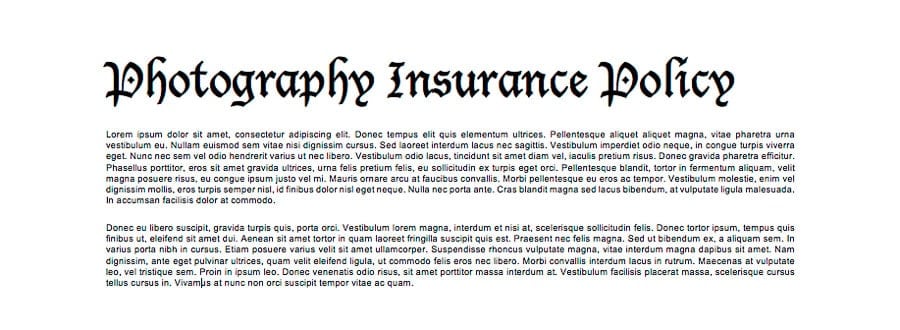
There are many reasons to have some kind of photography insurance and just about as many insurance products. Some policies are specifically targeted at photographers and some are more general purpose. Which is right for you?
Photographers accumulate a lot of gear, which can be lost, stolen or damaged. (Check out Jeremiah Gilbert’s tips for preventing theft and loss.) And, as we start taking paid jobs, an accident could hurt someone, a malfunction could ruin photos, damage to your studio could affect your income. You could be sued if a client or model is injured. The right insurance can help protect you and your earnings.
What follows is an overview of options available to photographers. Whether you talk to an insurance agent of shop for a policy online, be realistic about your coverage needs and be sure you read and fully understand all the fine print.
Homeowners/Renters Insurance
When you’re just learning photography, and starting to get good gear, your homeowners or renters insurance may well be all you need. Most policies cover equipment valued at up to $20,000 from theft, fire, flood, etc. while in the home. They may not, however, protect you from loss or theft while traveling or away from home—hiking at a nearby park, for instance. Some auto insurance will cover items stolen from your car, up to a certain value.
If you’re starting to accumulate a lot of costly gear that you couldn’t easily afford to replace on your own, then it’s probably worth talking to your insurance agent about other ways you can protect yourself, whether by increasing the covered value in your policy, adding a rider, or other options. State Farm, for example has a Personal Articles policy that could fit the bill.
Stated Value vs. Actual Cash
Pay attention to whether your policy covers the stated value or the actual cash value of your gear. Actual cash value is the depreciated value of your gear. You may find it difficult to buy replacement gear with what you’d get from a claim. With stated value, on the other hand, you state the value of the items (generally, the amount you originally paid) and the policy is written (or an endorsement is added) to reflect those numbers. That’s what you’d be paid in the event of a loss. It’s much closer to the amount you’d need to purchase new replacement gear, but is also more expensive than an actual cash value policy.
As you start taking paid jobs, your risks and your liabilities increase. When you’re using your gear for work, it may no longer be covered by homeowners/renters insurance. Some venues may demand proof of business and liability insurance.
If you’re just now setting yourself up as a business, Jim Harmer and Jesse Park have articles that will make the process easier and more effective.
If you’re getting into business, it’s time to start looking at your business insurance options.
Here are some of the types of business you can choose from. It’s a long list and you may not need all of them. Most insurance companies can write a single policy that covers as many of these categories as you want, so you won’t have to look for a dozen different policies and companies.
Equipment Insurance
Insure your gear against theft, accidents, various kinds of damage or other types of loss. Make sure you keep and up-to-date list of all your gear, including purchase price and date. One option, suggested by my insurance agent, is to photograph each item of gear and its purchase receipt and store the photos in the cloud. That way you have some proof of what you own and what you paid for it. Include your lighting gear, computer, backup hardware . . . everything connected to your photography business. One type of equipment insurance is called “inland marine,” which covers your equipment when you’re away from home, on location or traveling.
General Liability Insurance
What happens if someone trips on one of your light stands and injures themselves? Or that light stand falls and breaks an expensive glass-topped table? General liability protects you against claims for injuries sustained by someone or damage caused to something during the course of your photographic work. The amount and cost will vary, depending on your needs and exposure to risk.
Property Insurance
If you own or rent studio space in another building, you need property insurance. If you set up a studio in your home, talk to your insurance agent about making sure that is covered. This protects you against damage caused by fire, flood, wind, etc.
Business Owner’s Insurance
This will often combine general liability and property insurance, often for less money. Some policies, created for photographers, will also contain many of the following types of insurance, as well.
Professional Liability/Errors & Omissions Insurance
What would happen if you made a mistake and ruined all the photos from a wedding? Everybody, even an experienced pro, can make a mistake. And sometimes a client might be completely dissatisfied with your work. Errors and omissions insurance protects you and your business in the event that you make a mistake that causes financial harm to clients. Accidentally deleting the photos, showing up on the wrong day or time, not living up to someone’s expectations and such can ruin someone’s day. Don’t let it ruin your business, too.
Business Umbrella Insurance
Imagine the worst thing that could happen and then being sued for millions of dollars in damages because of it. Your standard business policies don’t generally provide that level of protection. A business umbrella policy provides extra coverage, into the millions, for a very reasonable price.
Commercial Automobile Insurance
Your personal auto insurance probably does not cover commercial activities and some places require commercial insurance if you use your vehicle in your business. Check with your auto insurance agent for the laws and regulations in your jurisdiction. You may find this applies to rental vehicles, too.
Photography Tours
If you are or are planning to lead photography tours and field workshops, having your clients sign a liability release may not be enough. You might need an additional layer of insurance. Taking paying customers to locations can be beyond the limits of some business insurance policies. Check the fine print or talk to your insurance agent.
These are the basic kinds of insurance products owners of growing photography businesses need to be looking at. You may not want each and every one as you begin your photographic journey, but it’s good to know the options. Armed with information, you can put together an affordable plan that gives you appropriate coverage for where your business is and where it’s headed.
And it’s well worth your while to reexamine your insurance options every year. Your business will be growing, your gear changing, and you may find your insurance needs evolving. Sometimes, you’ll find a better deal with a different mix of products or through a different insurance company.
As you grow, and are hiring assistants and second shooters, you’ll need to consider Employment Practices/Workman’s Comp insurance. As you keep more and more data and payment records, you may want to look at data security insurance. When photography becomes your sole or primary source of income, business interruption and disability insurance become important. And, if you’re using a drone regularly, you might want to have any damages caused by a drone crash covered through a drone liability insurance
Most of the big insurance companies have products that will fill photographers’ needs but they’re not the only sources of insurance. If you are a member of a photography or other professional association, check their insurance options. For example, the Professional Photographers Association (PPA) and the North American Nature Photography Association (NANPA) both offer insurance options to members. And doing a simple web search reveals too many options to mention, much less evaluate.
But evaluate you should. Not all insurance companies are financially sound and not all have good track records paying claims. Check AM Best, Fitch, Moody’s or Standard & Poor’s ratings for your insurance company choice.
Whether you talk to an agent or search the web, knowing your needs and your options can help you bet the best coverage and the best deal.


This is so useful hing for us.